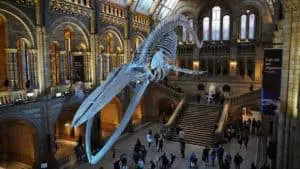Cryptozoology Cruises: Embarking on the Quest for Legendary Aquatic Creatures

Updated On: April 01, 2024 by Noha Basiouny
Embarking on a unique voyage across the world’s vast lakes and oceans, we partake in a thrilling quest fuelled by the enduring allure of the unexplained. Onboard cryptozoology cruises, we seek out the enigmatic creatures of lore that have, for centuries, captivated the imaginations of sailors and adventurers alike. Dubbed cryptids, these elusive beings—from Nessie of Lake Ness to the mighty Kraken—occupy the shadowy fringes of the natural world, bridging the gap between myth and possibility.
We delve into the realm of cryptozoology, not merely as a pastime, but as an earnest pursuit of the unknown. These journeys are meticulously designed to trace the storied history of sea monsters and lake beasts, weaving through the tapestries of cultural myths and eye-witness accounts. With each expedition, we bring together sceptics and believers, researchers and storytellers, to explore the evidence and challenge the dismissals, collectively inching closer to unraveling the truths that lie beneath the waves or behind the ripples of secluded lakes.
Table of Contents
Exploring Cryptozoology
In this journey through the world of cryptozoology, we shed light on what defines this field, identify trailblazing researchers, and examine how conventional zoology intersects with the hunt for elusive creatures.
Defining Cryptozoology
Cryptozoology is a fascinating branch of study that seeks to explore and document elusive and unidentified species that have yet to be recognised by mainstream science. This ranges from sea monsters to land-based creatures that capture the public’s imagination. Our focus is not only on the creatures themselves but also on understanding the cultural and historical contexts behind the myths and sightings.
Pioneers of Cryptozoology
The inception of cryptozoology is attributed to Bernard Heuvelmans, a respected figure known as the ‘father of cryptozoology’. In the 1950s, Heuvelmans pioneered a structured approach to the study of hidden animals, proposing scientific methods to validate sightings and accounts.
Cryptozoological Research and Zoology
Within the realm of cryptozoology, seasoned researchers like Richard Freeman, the Zoological Director of the Centre for Fortean Zoology, have ventured globally to gather evidence and investigate reports of mysterious creatures. This field collaboratively utilises zoological principles to ensure that every quest for cryptids is grounded in scientific rationale, aiming to discern fact from folklore.
Famous Sea and Lake Monsters
Embark with us on a journey through the annals of maritime folklore as we explore the enigmatic realm of sea and lake monsters, creatures that have captivated imaginations and provoked curiosity for centuries.
Loch Ness Monster
The Loch Ness Monster, affectionately known as Nessie, is perhaps the most celebrated aquatic enigma of Scotland’s Loch Ness. Tales of this elusive creature date back to ancient times, but it was the 1933 sighting that launched Nessie to stardom. Despite numerous expeditions and scientific studies, definitive proof of Nessie has remained as murky as the loch’s deep waters.
Kraken and Giant Squids
The legend of the Kraken, a gigantic sea monster of Norwegian lore, has terrified sailors for generations. Once thought to be mere myth, the existence of giant squids lends credence to these tales. These colossal beings, with tentacles capable of ensnaring ships, are a testament to the wonders and mysteries that lie beneath the waves.
Cadborosaurus and Other Serpents
Cadborosaurus, colloquially dubbed Caddy, hails from the Pacific Coast of North America. This sea serpent, with reported sightings along the coasts of British Columbia, has become a part of local legend. While evidence of Caddy’s existence is circumstantial, the intriguing accounts of this and other serpentine creatures continue to fuel our fascination with the unknown realms of our oceans and lakes.
Legendary Beasts of Land
In our exploration of the intriguing and often elusive creatures of cryptozoology, we focus on those legendary beings said to roam the vast expanse of the land.
Bigfoot and Sasquatch
Bigfoot, also known as Sasquatch, is a figure that has captured the imagination, especially in North American folklore. Witnesses assert sightings of this towering, hairy creature throughout forests, describing it as having human-like features. Bigfoot is akin to celebrity status in the world of cryptids, perhaps owing to the volume of anecdotal evidence and supposed encounters.
Yeti: The Abominable Snowman
The Yeti, often referred to as the Abominable Snowman, is another legendary humanoid reported to inhabit the Himalayan region. Local folklore speaks of a beast with a fierce disposition, and while its existence is steeped in legend, it nonetheless remains a symbol of the mysteries hidden within the world’s highest peaks.
Mokele-Mbembe and The Lost Dinosaurs
- Mokele-Mbembe: This cryptid is said to be a surviving dinosaur, specifically a sauropod, lurking in the Congo Basin’s rivers. The legends associated with Mokele-Mbembe resonate deeply with tales of prehistoric times, hinting at the possibility that relics from the Cretaceous period may still roam in the recesses of the Earth.
- The Lost Dinosaurs: Accounts of various other dinosaur-like creatures beyond the Mokele-Mbembe exist in different cultures, suggesting a worldwide mythos or folklore supporting the existence of these supposed Cretaceous survivors.
Though our expertise is founded on the vast riches of global cultures and natural history, the entities we discuss — Bigfoot, the Yeti, Mokele-Mbembe, and more — belong to an enigmatic world where mythology and reality blur, creating a tapestry of enduring legends.
Cultural Impact of Mythical Creatures

Mythical creatures have left a profound mark on culture, inspiring a wealth of tales and traditions that persist in modern society.
Literature and Cryptozoology
Literature has long intertwined with cryptozoology, giving life to mythical sea monsters and lake beasts that capture our imaginations. From 20,000 Leagues Under the Sea where Jules Verne introduced the formidable giant squid, to The Loch, where Steve Alten spins a modern tale of horror about Nessie, literature often breathes belief into these cryptids, blurring the lines between legend and possibility.
Cryptozoology in Media
In media, cryptozoology has become a genre-spanning theme. Documentaries like Loch Ness Monster: New Evidence throne our curiosity, while films such as The Water Horse vividly bring mythical creatures from mere whispers of folklore into vivid visual narratives. Cryptozoological creatures feature in video games too, often serving as formidable foes or intriguing quests, showcasing the depth of their cultural infiltration.
Folklore and Society
Folklore plays a pivotal role in society, embodying our collective fears and fascinations through tales of beasts such as the Kraken or mermaids. Societal customs and local economies often flourish around these legends, such as with the tourism industry in Scotland that thrives on the lore of the Loch Ness Monster. Such myths also serve to convey moral lessons or embody characteristics valued by the culture they originate from, thus perpetually influencing the societal fabric.
Evidence and Documentation
In the quest for cryptids, proper documentation and analysis of evidence are paramount. Recorded sightings and encounters offer tantalising glimpses into the unknown, whereas the role of witnesses and testimony adds a human element to the search. Finally, the analysis of physical evidence allows us to scrutinise the material proof of these mysterious creatures. Let’s explore how these elements combine in the pursuit of cryptozoological discovery.
Recorded Sightings and Encounters
- Date: 1994
- Location: Lake Dakataua
- Entity: ‘Migo’ Lake Monster
In 1994, Lake Dakataua in Papua New Guinea gained attention with footage of an unidentified entity named the ‘Migo.’ According to Tetrapod Zoology, the lake is noted for its size, depth, and unusual alkalinity—features that could support unknown species. Such recorded sightings, while compelling, often require further corroboration.
Role of Witnesses and Testimony
- Sea Serpent: Gloucester (Number of Witnesses: Scores)
- Consensus: Visible from shore or from a boat
Witnesses play a pivotal role, as their accounts form the bulk of evidence for cryptids. For instance, the sheer number of people who claimed to have seen the Gloucester sea serpent, as narrated on Lit Hub, lends a degree of credibility to the existence of such creatures. However, testimony alone isn’t conclusive and is subject to scrutiny.
Analysis of Physical Evidence
- Interpretation: Cryptozoological literature
- Assumption: Prehistoric creatures like plesiosaurs
Physical evidence, varying from blurry photographs to alleged body parts, constitutes another piece of the puzzle. Experts often analyse such material with the aim of identifying unknown animals. Caution is essential, as illustrated by RSB, because assumptions based on cryptozoological tradition may lead to misinterpretation. The reality behind the myths requires a scientific approach to differentiate fact from fiction.
Scepticism and Debunking Myths
Embarking on a journey through the realm of cryptozoology, particularly as it relates to sea monsters and lake beasts, requires a navigation through the waters of scepticism and the rigorous task of debunking myths. Our foray into this subject will scrutinise the sceptical views on cryptozoology, dissect the science behind mythical beasts, and evaluate the search for validity in cryptic claims.
Sceptical Views on Cryptozoology
Cryptozoology often swims in controversial waters, with sceptical researchers staunchly challenging the existence of creatures often recounted in legends and folklore. Critiques of cryptozoology emphasise the lack of empirical evidence and the reliance on anecdotal sightings, which frequently do not withstand scientific rigour. A sceptical lens focuses on the verification of data and asserts that most cryptids, when investigated thoroughly, trace back to misidentified known animals or outright fabrications.
The Science Behind Mythical Beasts
Turning our gaze towards the myths surrounding sea monsters and lake beasts, it’s imperative to understand the scientific explanations that often lie beneath the surface. Researchers in marine biology and zoology have sometimes revealed that eyewitness reports of monstrous creatures can be linked to known species, such as oarfish or decomposing carcasses of whales, which are mistaken for something more fantastical due to their unusual appearances or states of decay.
The Search for Validity
The quest for validity in the study of supposed sea monsters involves meticulous investigation and often leads to the demystification of legends. While cryptozoology cruises may offer the thrill of the hunt, legitimate inquiries must be anchored in sceptical scrutiny to separate fact from fiction. The commitment to this discipline aids in ensuring that any unlikely discovery is truly a contribution to science and not merely a perpetuation of myth.
Rediscovered Species

In the realm of cryptozoology, sometimes creatures once deemed mythical are found to be real, breathing new life into our understanding of natural history.
The Coelacanth Story
The coelacanth serves as a profound example of a species that, having been thought extinct for 65 million years, was rediscovered alive in 1938. This prehistoric fish, with its distinct lobed fins, was once only known from fossils and was believed to have vanished along with the dinosaurs. Its discovery off the coast of South Africa was nothing short of sensational, significantly altering our comprehension of survivorship and evolution within marine species.
Reclassifying Myth to Reality
The journey from myth to acknowledged reality is not only thrilling but also crucial for zoology. The rediscovery of the coelacanth embodies this transition, showcasing that the oceans still harbour secrets from our planet’s distant past. Each rediscovered species proffers a vital piece of the evolutionary puzzle, enabling us to piece together the rich tapestry of life. Through such findings, we see that the line between myth and reality is often much finer than previously imagined.
Contemporary Hunting of Monsters

In our article, we focus on modern efforts to uncover the truth behind legendary sea monsters and lake beasts through contemporary cryptozoological pursuits.
Modern Expeditions and Encounters
Decades ago, the pursuit of cryptids was often viewed as fringe science, but today, modern expeditions are meticulously planned with a scientific approach. Researchers set sail equipped with the latest technology, hoping to gather evidence of creatures such as the fabled Loch Ness Monster or the elusive sea serpents reported by sailors throughout history. These encounters, while rare, continue to tantalise and drive the field forward.
Resources and Equipment Used in Research
Cryptozoologists now employ a range of resources and equipment in their research, from sonar and underwater cameras to DNA analysis tools. This arsenal equips them to systematically catalogue findings and compare them against known wildlife species. By analysing environmental DNA (eDNA), for instance, we can detect genetic material left by creatures to identify their presence in a body of water.
Ethics of Cryptozoological Hunts
The ethics surrounding the hunt for unknown species is paramount. Our hunts must respect wildlife and habitats, minimising any potential disruption. This consideration ensures that the pursuit of myth does not come at the expense of the very real ecosystems we explore. Responsible research practices enable us to maintain the delicate balance between discovery and conservation.
Regional Focus on Cryptozoology

In this section, we explore how regional folklore and sightings of mysterious creatures have become a focal point for those interested in cryptozoology, particularly within the context of British Columbia, Gloucester, and Washington. These areas are rich with tales of elusive maritime creatures that lurk in the depths of their waters.
Cryptozoology in British Columbia
British Columbia is renowned for its tales of enigmatic beasts such as the legendary ‘Alma’—a creature akin to the more famous Bigfoot. Local reports describe Alma as a sasquatch-type entity dwelling in the region’s dense forests. Furthermore, British Columbia’s coastlines and inland waters serve as a backdrop for numerous sea and lake monster legends, attracting adventurers and cryptozoologists each year who hope to catch a glimpse of these elusive creatures.
Legends of Gloucester and Washington
Gloucester, Massachusetts, has its own historic association with sea monsters, recorded as far back as the 1600s. These ancient maritime legends contribute to Gloucester’s identity and lure cryptozoology enthusiasts in search of the truth behind such stories. Moving to the West, Washington State’s waters are no strangers to reports of mysterious aquatic beings. Lake monsters, similar to the storied Loch Ness Monster, are said to dwell within some of the state’s numerous lakes, giving rise to local folklore that fuels cryptozoology discussions and expeditions.
Educating the Public and Community Engagement
Cryptozoology cruises not only seek to unravel the mysteries of purported sea monsters and lake beasts but also aim to enhance public understanding and community involvement. We facilitate this through organised exhibitions, informative public talks, and collaborative community witness programmes, all centred around presenting diverse perspectives and sharing knowledge on these elusive creatures.
Exhibitions and Public Talks
We curate exhibitions that showcase evidence and cultural artefacts associated with sea monsters and lake beasts. These exhibitions provide a visual and educational experience, enhancing the viewer’s understanding of cryptozoology. Complementing these displays, our public talks serve as an interactive platform for experts to share their knowledge, allowing attendees to pose questions and learn from credible sources. Notably, we present information with clarity and structure, making it engaging and informative for audiences across varying levels of familiarity with the subject.
Structured Highlights of our Exhibitions and Public Talks:
- Visual Displays: From artist renditions to alleged photographic evidence.
- Expert Insights: Talks by marine biologists, cryptozoologists, and folklorists.
- Q&A Sessions: Opportunities for the public to engage with experts.
Community Witness Programmes
Our Community Witness Programmes invite firsthand accounts from individuals who have claimed to encounter these enigmatic creatures. We meticulously document these narratives and ensure they are treated with respect and neutrality. These programmes foster a sense of community and collaboration as we work together to piece together the experiences shared by local witnesses.
Key Aspects of our Community Witness Programmes:
- Documentation: Gathering and recording witness testimonies.
- Respectful Engagement: Validating community voices without bias.
- Shared Learning: Enabling the community to contribute to our growing database of sightings and stories.
Concluding Thoughts on the Search for the Unknown

Embarking on voyages in pursuit of the elusive sea monsters and lake beasts, we’ve ridden the waves of curiosity and skepticism. Navigating through myths and stories of creatures like the Loch Ness Monster and various sea serpents, we’ve delved into the heart of our fascination with the unknown.
We must remember that the field of cryptozoology, while often marred with dubious claims, does play a role in our quest for scientific discovery. It carries the potential to unearth not merely myths, but possibly new aquatic species that have evaded traditional zoology.
- Monsters: A term that captivates and terrifies, drawing us into the depths of our imagination.
- Unknown Animals: Reminders that our planet still harbours secrets, waiting to be discovered.
- Loch Ness Monster: A beloved enigma that continues to attract seekers to the Scottish Highlands.
- Sea Serpents: Creatures of maritime lore that have persisted in the consciousness of seafarers for centuries.
In our yearning to understand the world around us, the allure of monsters and unknown animals speaks volumes about our innate love of storytelling and exploration. The search for these beings, while often met with doubt, encourages us to look closer at our environment, to question, and to explore.
Through our collective efforts, the sea of Cryptozoology Cruises is neither purely a pursuit of fantasy nor of folly. It is a testament to our undying curiosity and the ever-present possibility that our planet still holds many creatures in its vast and unexplored waters. As we chart these mysterious waters, we invite you on this journey, to ponder the existence of these enigmatic beings, and to embrace the continuous search for the unknown.
Frequently Asked Questions
In this section, we tackle the most common queries about the thrilling world of Cryptozoology Cruises, lending insights into the adventures that await in the quest for the elusive denizens of the deep.
What are some of the most elusive sea monsters pursued by cryptozoology enthusiasts?
One of the most sought-after creatures is the legendary Nessie, the Loch Ness Monster. Others include the Ogopogo in Canada’s Okanagan Lake and the Lake Dakataua ‘Migo’ in Papua New Guinea, which at its deepest reaches 122 metres.
How do cryptozoology cruises ensure the safety of participants while searching for lake beasts?
Our cruises prioritise participant safety, employing experienced guides knowledgeable about the local wildlife and environment. All trips are equipped with safety gear and follow strict protocols to ensure a secure adventure while tracking mysterious lake beasts.
What techniques are used in cryptozoology cruises to locate and study cryptids in aquatic environments?
We employ a combination of sonar readings for below-surface exploration and night-vision equipment for observations in low-light conditions. These methods help us to monitor and document aquatic cryptids while minimising our interference with their natural habitat.
Could you list the types of equipment typically employed on cryptozoology cruises?
Onboard, our expeditions are equipped with high-definition cameras for documentation, sonar for mapping sub-surface movements, and environmental DNA (eDNA) sampling tools to detect the presence of cryptids without the need for visual confirmation.
What are the most notable discoveries made by cryptozoology cruises in recent years?
Although incontrovertible proof of sea monsters remains elusive, significant findings include unexplained underwater recordings and samples that suggest the presence of large, unidentified aquatic organisms not yet recognised by science.
How do experts differentiate between myth and plausible cryptid sightings during expeditions?
Our experts scrutinise each sighting by cross-referencing with known species, examining the credibility of witness accounts, and conducting thorough analyses of any physical evidence collected during the expeditions to rule out myths and focus on plausible accounts.






